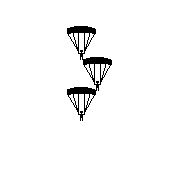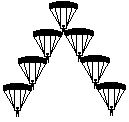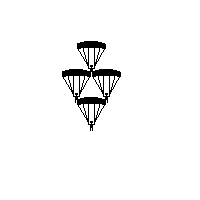 CRW Training Drills
CRW Training Drills

Diamond Quest suggests the following training to get a jumper up to each standard :-
Novice moving on to Intermediate
- Practice flying relative, get comfortable in flying side by side and doing end cell bumps.
- Base-pin practice with an experienced CRW person, alternating between base and pin.
- Have experienced CRW person setup base high then low relative to the novice to give the novice practice basic flying maneuvers (sashay, spiral FDR, rear risers, etc.) to get to the base.
- Do 3, 4, 5, and 6-way rotation dives to give novice docking practice on vertical formation of various sizes.

Beginning Intermediate moving on to Advanced
- Continue to work on 3, 4, 5 and 6-way rotations. Move the jumpers around so they get a chance at each slot out the door. Concentrate on proper Echelon flying and the skills needed to get into the correct spot in the sky. The use of sashay rotation is encouraged for the following reasons :-
- Smooth piloting skill : It teachs a pilot to control a formation that tends to "follow" the rotating jumper as they leave.
- Canopy control skills : Rotating jumpers are not working on the center line of the formation. They must use toggle turns, front riser turns and dives to set up their approach. This gives the rotating jumpers a lot of canopy skills practice on each rotation.
- Echelon, Approach, Canopy skills : At the start of the sashay (first outboud turn) the jumper finds himself/herself fairly level and along-side the formation, this is much like a good lurking position that is used on most approaches to a building formation. This gives them good practice at setting up an approach (the inbound sashay) from a position that is much like their echelon after exit.
- Develop range of canopy skills : Starting with a 3-way, the approach set up is different on each formation through the 6-way. By exposing jumpers to varying size formations, they will learn to adjust their set up to match the formation.
- The Wedge Rotation :
With the instructor as pilot, build a stair step with on novice and allow another novice to shoot the other wing slot. Once heshe has docked and settled into proper trim, release the first novice. He/She should make a lifting turn away and set up an approach to re-form the wedge. Keep dropping each wing and allowing them to re-dock, This gives novices wing docking and wing flying skills, proper approach and set up.
- Step-Back Rotation :
 In this drill a jumper rotate like in a vertical sashay. This
dive gives each jumper the chance to pilot an offset formation,
accept an offset grip while flying their wing in proper trim and
dock a wing slot (the slot changes sides each time through).
This drill can be done with 4 or even 5. The stability of the
formation will be more challenging as the number of jumpers
increases.
The step-back rotation is very challenging. You may
want to start out with a simple three-way stair step at first, and
after mastering that, move on to the step-back.
In this drill a jumper rotate like in a vertical sashay. This
dive gives each jumper the chance to pilot an offset formation,
accept an offset grip while flying their wing in proper trim and
dock a wing slot (the slot changes sides each time through).
This drill can be done with 4 or even 5. The stability of the
formation will be more challenging as the number of jumpers
increases.
The step-back rotation is very challenging. You may
want to start out with a simple three-way stair step at first, and
after mastering that, move on to the step-back.
- Work on building 4 and 9-way diamonds. After mastering the three previous drills, the diamond is a nice application of the skills learned.

Continued training for Advanced flyers
The major difference between Advanced and Intermediate flyers is that an Advanced flyer has shorter splits to his/her dock, is much smoother and more in control and can teach.
- Build Diamonds and Boxes - Work jumpers through all slots. building an off set, off center (the box) is a good way to build skills in piloting and using proper trim. Emphasis should be on smooth correct technique in all areas - tight exit, proper echelon, great set up, use very little air space, smooth straight-in approach, set trim if needed, accept and facilitate incoming docks, proper grips, good communication, good breakdown, demonstrate air-awareness in the post dive.
- Work with Novices - When jumping with Novices, it is important to have a successful dive if the Novices are to learn. This forces the Advanced flyer to be extra "heads up" in order for the dive to work.
- Sequential - Use the current competition dive pool to practice the block formations - there are easy and challenging ones. Each block is a good skill dive if repeated.
- To really work on no momentum wing docks, gentle piloting and very subtle trim, build the wing -

- To work on flying open tops, build a 4-way diamond and rotate the point to the bottom. This leaves the tee -

Do this with the 9-way
diamond and leave 3-wide
across the top.
- Another challenging drill is the diamond-accordion rotation - start with a diamond and rotate the pilot to the bottom to form an accordian; now take the outside top and rotate to the bottom to form a new diamond.

- To get experience with wide wings, you can build wedges instead of diamonds. A 10-way wedge will give you Row 4 experience without having sixteen people. This also requires good dive engineering and proper formation flying to keep it stable.

 CRW Training Drills
CRW Training Drills![]()
![]()
![]()
 In this drill a jumper rotate like in a vertical sashay. This
dive gives each jumper the chance to pilot an offset formation,
accept an offset grip while flying their wing in proper trim and
dock a wing slot (the slot changes sides each time through).
This drill can be done with 4 or even 5. The stability of the
formation will be more challenging as the number of jumpers
increases.
The step-back rotation is very challenging. You may
want to start out with a simple three-way stair step at first, and
after mastering that, move on to the step-back.
In this drill a jumper rotate like in a vertical sashay. This
dive gives each jumper the chance to pilot an offset formation,
accept an offset grip while flying their wing in proper trim and
dock a wing slot (the slot changes sides each time through).
This drill can be done with 4 or even 5. The stability of the
formation will be more challenging as the number of jumpers
increases.
The step-back rotation is very challenging. You may
want to start out with a simple three-way stair step at first, and
after mastering that, move on to the step-back.
![]()



![]()